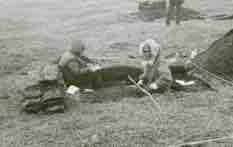Inuit Art
Inuit art refers to artwork produced by the people of the Arctic, or Inuit people, who were previously known as Eskimos. Inuit culture begins with the Pre-Dorset cultures as far back as 4000 BCE, and spans through the Thule cultures of 1000 CE until present day.
Pre-Dorset and Dorset Cultures
Around 4000 BCE, nomads known as the Pre-Dorset or the Arctic Small Tool tradition (ASTt) crossed over the Bering Strait from Siberia into Alaska, the Canadian Arctic, Greenland, and Newfoundland. Very little remains of them, and only a few preserved artifacts carved in ivory could be considered works of art.
The Dorset culture, which became culturally distinct around 600 BCE, produced a significant amount of figurative art using media such as walrus ivory, bone, caribou antler, and on rare occasions, stone. Ivory from walruses and narwhals in particular was the preferred material for carving utensils, tools, and weapons among Pre-Dorset and Dorset artisans. Subjects included birds, bears, walruses, seals, and human figures, as well as remarkably small masks. These items had a magical or religious significance, and were either worn as amulets to ward off evil spirits or used in shamanic rituals.
Carving of a polar bear
Dorset culture. Ivory. Alamek site, Iglulik, Canada.
Archaeology has been critical to adding to knowledge about them because the Dorset were essentially extinct by 1500 due to difficulties in adapting to the Medieval Warming Period.
Ipiutak Culture
The Ipiutak culture represents a classical period of Inuit development. The culture arose between 100 and 200 BCE and collapsed around 800 CE. The artwork is extremely elaborate, incorporating geometric, animal, and anthropomorphic designs.

Ipiutak archaeological site at Point Hope in northwest Alaska
The Ipiutak culture arose c. 100–200 BCE and collapsed around 800 CE.
An Ipiutak archaeological site at Point Hope Alaska is renowned for its mortuary offerings, one of which is termed a "mask." One Point Hope Ipiutak mask represents a human face with a gaping mouth and blowfly larvae issuing from its nostrils, a symbol rife with shamanistic implications. The mask, identified as having belonged to a child, contains a stylized mouth and eyebrows and a naturalistic nose, as if it had been modeled upon an actual face. Two pointed objects likely covered the eyes.
Child's Funerary Mask
Ipiutak. Point hope, Alaska.
Thule Culture
Around 1000 CE, the people of the Thule culture, ancestors of today's Inuit, migrated from northern Alaska and either displaced or slaughtered the earlier Dorset inhabitants. By the thirteenth or fourteenth century, the Thule had occupied an area currently inhabited by the Central Inuit, and by the fifteenth century, the Thule had fully replaced the Dorset culture. Contact with Europeans began in the sixteenth century and intensified in the eighteenth century. Compounded by the already disruptive effects of the "Little Ice Age" (1650–1850), the Thule communities broke apart, and the people were henceforward known as the Eskimo, and later as the Inuit.
Thule art had a definite Alaskan influence and included utilitarian objects such as combs, buttons, needle cases, cooking pots, ornate spears, and harpoons. The graphic decorations incised on them were purely ornamental, bearing no religious significance. They were simply meant to make utilitarian objects look appealing.
All of the Thule objects were made by hand from natural materials, including stone, bone, ivory, antler, and animal hides. Nomadic people carried tools necessary for their daily living and could take very little else with them. Non-utilitarian objects were also carved in miniature so that they could be carried or worn, such as dance masks, amulets, fetish figures, and intricate combs and figures which were used to tell legends and objectify their mythology and oral history.
The Classic Thule tradition (1100-1400) relied on the bowhead whale for survival because bowhead whales swim slowly and sleep near the surface of the water. Bowhead whales served many purposes for the Thule people, including meat for food, blubber for oil (used in cooking, heating, and providing light), and bones could for building structures and making tools. A Thule site in Resolute Bay, Nunavut contains an example of a home whose frame used whale bones.
Whalebone used in the building of an ancient Thule home.
Resolute Bay, Nunavut, Canada.